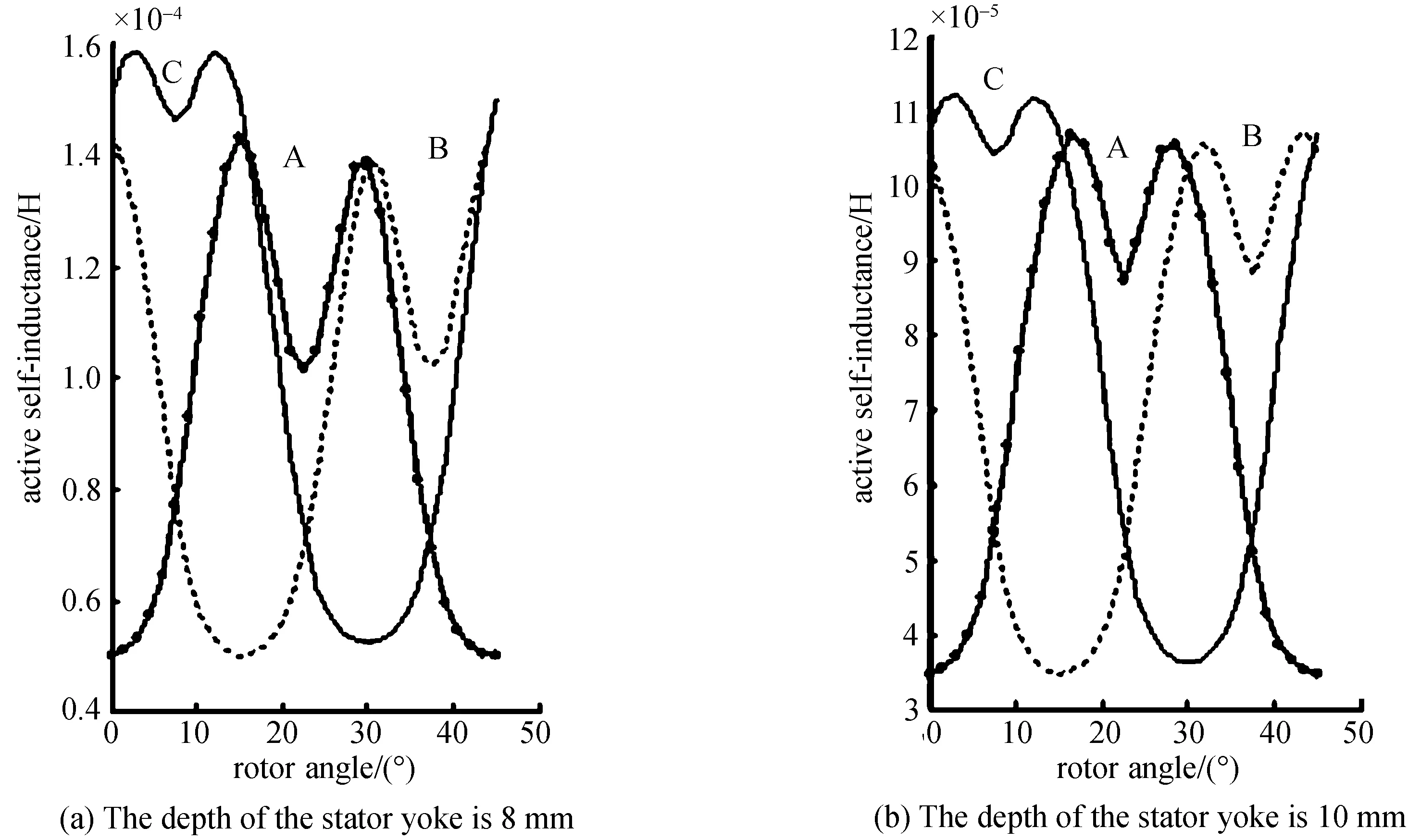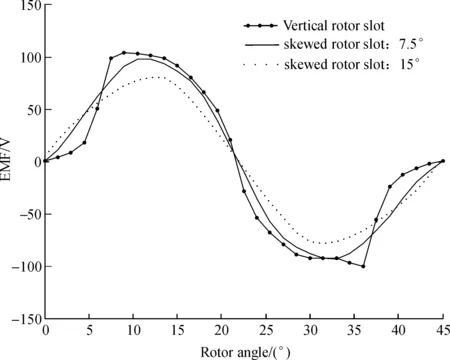Effects of Structure Size of the Doubly Salient Permanent Magnet Machine on Its Function
2011-11-23SUNYapingANKang
SUN Ya-ping, AN Kang
(Qianjiang College, Hangzhou Normal University, Hangzhou 310012, China)
Effects of Structure Size of the Doubly Salient Permanent Magnet Machine on Its Function
SUN Ya-ping1, AN Kang1
(Qianjiang College, Hangzhou Normal University, Hangzhou 310012, China)
This paper proposed a novel 12/8-pole doubly salient permanent magnet(DSPM) machine with four pieces of tile-shaped PMs buried in the stator laminated core.Basing on the two-dimensional (2D) finite element analysis (FEA), the paper analyzed the configuration, the basic principles and the nonlinear modeling of this machine, and investigated the effects that the structure size variation of the machine on its function, such as the stator yoke, the rotor arcr and the skewed rotor slots, proposed an optimized control topology to improve the performance of DSPM as well.
doubly salient permanent magnet machine; structure size; optimized control topology
1 Introduction
Research interest in the switched reluctance machine (SRM) has grown significantly in recent years.It offers the advantages of simple structure, fault tolerance, and mechanical robustness, leading to be attractive for industrial and electric vehicle applications.Nevertheless, its inherent limitations, such as excitation penalty, control complexity, noise, and vibration, have prompted research into the incorporation of permanent magnets (PM) into the basic SRM structure.One of the new topologies proposed recently is the doubly salient permanent magnet (DSPM) machine, which essentially adopts the same structure as the SRM but with PMs placed in the stator or the rotor.It is shown that the DSPM machine combines the advantages of the SRM with high efficiency, high power density, and high energy conversion ratio[1].
Recently, many literatures have already illustrated the structure, the principle and the control of the DSPM machine.However, the effects of structure variation on this machine, being the fundamentals for both design and control, have received insufficient research.
The objective of this paper is to perform the analysis of the effects of structure variation by using finite element method (FEM), and hence to calculate the basic characteristics.The iron saturation, the slot effect and the cross-coupling between the PM flux and armature flux will be taken into consideration.Furthermore, a new method for controlling the armature current is proposed and the cogging ripple is discussed detailedly for the DSPM motor.A novel 12/8-pole DSPM machine with stationary PMs is designed, simulated for exemplification in ANSYS.
2 Magnetic Field Analysis
Fig.1 shows the cross section of the proposed 3-phase, 12/8-pole DSPM machine with four pieces of tile-shaped PMs buried in the laminated core.Under assumptions that the vortex effect is neglected, a circular zero magnetic vector potential boundary is used, and the hysteresis is negligible[2], a two-dimensional (2D) magnetic modeling is processed in ANSYS.
Digital simulations have been carried out for the design of the prototype DSPM machine.Machine data is shown in Tab.1.

Fig.1 Cross-section of DSPM machine
Tab.1DesigndataoftheDSPMmachine

Parameter ValueCorematerialD41Rotor/Statorpolearc/(°)30Rotorouterdiameter/mm78Rotorinnerdiameter/mm58Rotorpoledepth/mm20.5Airgaplength/mm0.8Numberofarmaturewindingturns24Ratedarmaturecurrent/A120Stacklength/mm100Statorpoledepth/mm14.7Statorouterdiameter/mm166Statorinnerdiameter/mm150CoerciveforceofPM/(KA/m)600PMthickness/mm7Ratedspeed/rpm6000Ratedpower/KW300
In this paper, the full-alignment of the rotor is assumed to occur at 22.5°.Fig.2 gives the flux distributions of the PM field at no-load and the armature field at the phase current of 120 A for the 7.5orotor position.It can been seen from Fig.2 (b) that most of the armature flux loops through adjacent stator poles and only a little portion passes through the PMs.Therefore, the DSPM machine is less sensitive to the demagnetizing effect of the armature flux than traditional PM machines.

Fig.2 Magnetic field distribution
3 Effects of Structure Variation
3.1 The Stator Yoke
Fig.3(a) shows the inductance characteristics of the prototype DSPM machine.It indicates that the self-inductances of 3-phase armature current is so asymmetric that it will lead to the degradation of performance.The main reason for this feature is that the PM is a large reluctance and the magnetic circuits of 3-phases are different.As a result, the magnetic resistance of the A (or B) phase is larger than that of the C phase when the stator yoke is highly saturated.However, when the depth of the stator yoke is wider, the magnetic reluctance of the iron is much less because the degree of saturation is descendent.Therefore, the magnetic resistance of three phases, mostly provided by the air-gap magnetic reluctance, is nearly equable.Fig.3 (b) indicates that the DSPM machine can operate in a symmetric mode under a 10 mm-deep stator yoke condition.

Fig.3 Self-inductance of phases a-c
3.2 The Rotor Arcr

Fig.4 Flux linkage vs.rotor angle for various rotor arcr
Based on the FEA, the influences of the rotor arcr are analyzed in detail and its waveforms are shown in Fig.4.In Fig.4, one can observe that the rotor arcr plays an important role for the flux linkage.As the rotor arcr is increases, the maximum flux linkage reduces in magnitude and the slop value.In addition, the active self-inductance and the mutual-inductance increase with the rotor arc increasing.
Consequently, the performances of the DSPM machines with varied rotor arcr are compared, such as the total harmonic distortion of the electromotive force (EMF), the torque ripple, the average electromagnetic torque, and the average output voltage produced by the non-controlled rectifier.Comparison results at rated-load are shown in Tab.2.

Tab.2 Characteristics under different rotor arcr(n=6 000 rpm)
In Tab.2, as the rotor arc increases, the waveform of EMF looks more like pure sine wave, so the THD decreases.Voltage ripple will be the lowest at 31.5° may be the interaction between the amplitude reduction of EMF and the sine waveform.
Tab.2 indicates that the performances of the proposed DSPM machine are perfect when the rotor arcr is 31.5°.
3.3 The Skewed Rotor Slots

Fig.5 Derivative of flux linkage with respect to rotor position
As a partial derivative of pole flux linkage with respect to rotor position, the armature EMF is induced in each of the stator windings at no-load as shown in Fig.5.From Fig.5, it is seen that the back EMF term with a vertical rotor slot is just like a trapezoidal.But, for the DSPM machine with appropriate rotor skewing, the back EMF is very close to sinusoidal waveform.It was proved that other negative influences such as magnetic torque harmonics, cogging torque and voltage ripple could be reduced when skewed rotor slots were used.Therefore, optimization of the skew angle of rotor slots in DSPM machines should be further researched.
4 Control Topology
Due to the existence of PMs and doubly salient structure, there are two kinds of torque produced in DSPM machine: the PM torque and the reluctance torque.The currents must be controlled properly with the variation of phase PM flux linkage to obtain maximum PM torque which is normally the desired torque in this design as shown in Fig.6 (a).When PM flux linkage increases with rotor position angle, a positive phase current is applied to the winding, resulting in a positive torque.When PM flux linkage decreases, a negative current is applied to the winding, also resulting in a positive torque.Thus the two possible torque-producing zones are all utilized.

Fig.6 Phase current waveforms
When a two-stroke rectangular current, as shown in Fig.6 (a), is applied to the phase winding, the total static torque is the first line shown in Fig.7.Obviously, the total electromagnetic torque of the DSPM motor, just like the VRM, varies largely with rotor position and the torque ripple is acutely, which may prevent the machine from being used for applications where torque quality is critical.

Fig.7 Total static torque at Ip=120 A
According to the operation principle of motor, the torque is governed by the induced EMF.Therefore, a new control topology, in which the phase change occurs at the crossing points of the 3-phase EMF, is proposed as shown in Fig.6 (b).In this case, the total static torque is produced just as the second line shown in Fig.7.Therefore, the second control topology takes advantages over the first one in that the torque ripple is reduced by 35.84% and the average torque is increased by 6.74%.
5 Conclusions
This paper proposes a new 12/8-pole DSPM machine and the magnetic field distribution has been analyzed by FEA.The control strategy of the machine has been developed.Besides, the performance and structure of the machine have also been explored.Finally, conclusions drawed in this paper are summarized as follows:
1) A good control topology is advantageous in terms of the operating performance.
2) Choosing a proper depth of the stator yoke will achieve symmetry and reduce the cogging torque.
3) The performances are perfect when the rotor arcr is 34.5°.
4) Optimization of the skew angle of rotor slots will reduce the negative influences such as magnetic torque harmonics, cogging torque and voltage ripple.
All of these advantageous features make this machine a competitive candidate for those applications desiring high efficiency, high power density, and torque critical, such as electric vehicles.
[1] Cheng Ming, Chau K T, Chan C C.Design and analysis of a new doubly dalient permanent magnet motor[J].IEEE Transactions on Magnetics,2001,37(4):3012-3020.
[2] Sarlioglu B, Lipo T A.Nonlinear modeling and simulation of single phase doubly salient permanent magnet generator[C]//Industry Applications Conference.Thirty-Third IAS Annual Meeting.The 1998 IEEE, USA:St.Louis, MO,1998:18-26.
[3] Wei Hua, Cheng Ming.Inductance characteristics of 3-phase flux-switching permanent magnet machine with doubly-salient structure[C]//Proceedings of Power Electronics and Motion Control Conference.Portoroz: IEEE,2006:1-5.
[4] Yu Gong, Chau K T, Jiang J Z,etal.Design of doubly salient permanent magnet motors with minimum torque ripple[J].IEEE Transactions on Magnetics,2009,45(10):4704-4707.
双凸极永磁电机结构尺寸对性能的影响
孙亚萍,安 康
(杭州师范大学钱江学院信息与机电工程分院,浙江 杭州 310012)
提出了一种新型12/8极的双凸极永磁电机,该电机定转子铁芯均由硅钢片叠压而成.通过2D有限元计算和仿真分析了电机的结构、基本工作原理和非线性建模,并讨论了电机结构尺寸变化对其性能的影响,如定子磁轭厚度、转子极弧宽度和转子斜槽角度.最后对电机的控制策略进行了优化.
双凸极永磁电机;结构尺寸;控制策略优化
date:2010-10-27
Supported by Scientific Research Project of Hangzhou Normal University Qianjiang College(2010QJJL04).
Biography:SUN Ya-ping(1980—), female, born in Jinhua, Zhejiang Province, master, majored in power electronic.E-mail: syp8037@yahoo.com.cn
10.3969/j.issn.1674-232X.2011.04.015
TM351ArticlecharacterA
1674-232X(2011)04-0359-05
